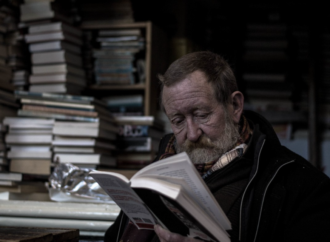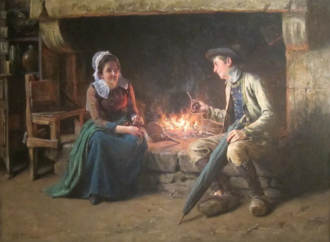In late December, I agreed to teach a Latin class in a small, private Catholic school here in Front Royal, Virginia. The headmistress had approached me several times in years past about coming back to the classroom, but always, I had refused, in large part because of my already hectic schedule.
This time was different. The upper division of the boys’ school had gone through some turmoil and was in danger of shutting down, so I agreed to help out. Getting away from my keyboard, I thought, might be healthy, and the school was less than a quarter mile from my favorite coffee shop. Classes would meet for 45 minutes a day Mondays through Thursdays, and because I taught the textbook we’re using for over 20 years to seminars of homeschoolers, class prep would take me less than five minutes every evening. Easy-peasy, as a friend of mine used to say.
Now, three weeks into the class, I can say that climbing back onto this horse felt as natural to me as pouring that first cup of morning coffee. Just as I used to tell others that my many seminars of homeschoolers made for a “teacher’s heaven,” the same holds true for the eight boys ages 12 to 15 studying Latin. My main problems are the usual ones of getting some of them to pay attention in class and to do their homework.
Here are several reasons why this classroom and this school work to the advantage of the students and their teachers.
The class sizes are small. Already, the boys and I know each other reasonably well.
The school is all-male. Its sister school is all-female. The battle of the sexes doesn’t exist in these classrooms.
The school focuses on the basics: math, humanities, science, foreign language, and religion. Physical education also is a regular part of the curriculum. Here you’ll find no fluff courses or DEI shenanigans.
All of my students, as far as I know, come from intact families consisting of a father, a mother, and siblings. The parents are clearly interested in their boys’ education, otherwise they wouldn’t have gone to the extra trouble to enroll their children in a private school.
All of my students are Catholic, members of the burgeoning Roman Catholic community here in town. They are catechized at home, in church, and in school, and they share important core beliefs and values. Faith and education are woven together and honored.
Finally, the boys and their families know each other well. Many of them are close friends.
These positive practices and commonalities create fertile ground for learning. If we include homeschoolers, there are tens of thousands of other such schools all across the United States effectively educating the young. Opposite them are those centers of education, mostly public schools, which are failing in this mission. To change for the better, the administrators and teachers of those schools might take some lessons from their more successful counterparts.
Here are some boiled-down takeaways for making these improvements.
Small classes mean more teacher attention per pupil and more student accountability.
Teaching the basics is critical. Students who leave school illiterate in reading or history, or incompetent in mathematics, will find themselves carrying the weight of those educational failures for the rest of their lives. It’s critical to bear in mind the often overlooked fact that the rest of society will be carrying that weight as well.
“Diversity is strength.” We’ve heard that slogan for decades, but if we look around our country, the failures of that cliché are all around us. It’s time to junk this discredited idea and instead raise up a banner of commonality in our schools. Teaching a shared code of ethics and expected classroom behavior from kindergarten on might do wonders to restore our broken society.
The advantages of classes separated by sex, especially in the teen years, have long been acknowledged by experts. In “The Advantages of Single-Sex Education,” for instance, Teresa A. Hughes effectively argues for our public schools giving students and parents this alternative, citing such positive evidence as improved behavior in the classroom and the learning style differences between girls and boys.
If we wish to make more of our schools effective again, we have to make classrooms vehicles for real learning. We see this sort of learning going on in homeschools and private schools all around the country. Educators and administrators in failing schools should drop their prejudices against private education and take a look at methods of education that are working for the betterment of our young.
—
Image credit: Pexels















